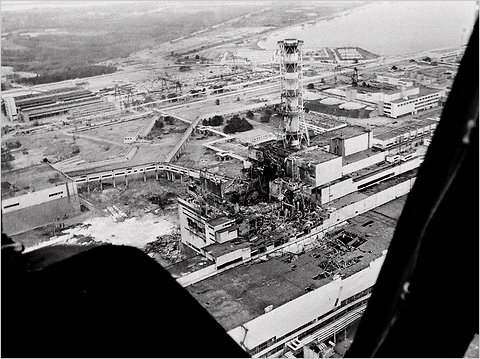March 16

Associated Press Chernobyl’s No. 4 reactor, seen from a helicopter
a few days after the April 1986 explosion.
When I look back on the explosion and fire
at the Chernobyl nuclear plant, which unfolded when I was living in the
Soviet Union in 1986, I reflect on how that plant differed from the Fukushima
Daiichi site in Japan. There’s the reactor design, for one, and the cause
of the explosions that ruptured buildings — in Chernobyl's case, a botched
safety experiment, and at Fukushima Daiichi, an epic earthquake and resulting
tsunami.
And although some have expressed frustration
over the amount of information being released, Japanese officials have
been far more forthcoming than the Soviet leadership was in the days after
the Chernobyl explosion.
Still, there are sparks of recognition that
drive home the similarities, too — for example, the selflessness of the
Japanese
plant workers laboring in the radiation danger zone, described by my
colleagues Keith Bradsher and Hiroko Tabuchi in Wednesday's newspaper.
I thought instantly of the firemen from the town of Pripyat, Ukraine, who
took their hoses onto the roof and directed water into a hole that opened
onto blazing fires and exposed fuel rods.
And in reading about evacuations from the
area around the troubled Japanese plant, I recall TV images of a seemingly
endless line of school buses removing residents from a 30-kilometer exclusion
zone around the Chernobyl plant.
The images of heroic firemen and a protected
populace were, of course, the spin that the state-controlled press put
on an out-of-control situation. Just to show how thoroughly things were
in control, Ukrainian Communist Party officials insisted on having the
annual May Day parade in Kiev less than a week after the explosion. I remember
jumping out of a chair and swearing as the camera showed pictures of proud
little Ukrainian girls, in pigtails and bows smiling as they marched down
the streets while radioactive particles wafted down, unseen.
I wasn't the only one to notice what was being
sacrificed to state propaganda. Not much could stay hidden from a Soviet
public that was long accustomed to being lied to. Word quickly spread that
the same party officials who ordered up that tableau of celebration had
sent their own children away. And within a few days, trainloads full of
Ukrainian children, car after car with windows full of small, nervous faces,
began arriving at the Kiev Station in Moscow.
|
suite:
When I went to the station, a woman accompanying
them assured me they were just making a normal trip to Moscow to see relatives.
Nothing to see here, move on. The message was reinforced by a hostile man
wearing the kind of black leather jacket favored by the thugs who worked
as government enforcers: he approached me with an air of authority and
told me to get lost. "Who gave you permission to ask questions at the
Kiev Station?" he growled.
I became more familiar with the Kiev Station
over the next year as I made a series of reporting trips to Kiev, the Ukrainian
capital, and Chernobyl. Every time I visited, street-cleaning trucks were
constantly spraying water to keep the dust down and keep radioactive particles
from blowing around. The pretense of normalcy presented in the May Day
parade did not last much longer than the parade itself.
But there was one part of the carefully crafted
story that required no hyping, though the Soviet authorities could not
resist hyping it for all it was worth. What the firemen did on the roof
of the reactor that night was as fine an example of self-sacrifice as one
could find.
Most died within two weeks from acute radiation
sickness. A shift commander, Lt. Leonid Telyatnikov, survived a debilitating
case of radiation sickness, though the younger firemen under his command
died from the exposure. Lt. Telyatnikov's hair had regrown when I interviewed
him about a year after the disaster. His description of the scene was haunting.
"As we were putting out the fire, you had
the impression you could see the radiation. First a lot of the substances
there were flowing, luminescent, a bit like sparklers. There were flashes
of light springing from place to place as if they had been thrown.
And there was a kind of gas on the roof
where the people were. It was not like smoke. There was smoke, too. But
this was a kind of fog. It gave off a peculiar smell."
He did not want to talk about the chances
that the heavy dose of radiation he absorbed on the roof could result in
cancer in coming years. "I expect to grow old," he said.
He died of cancer in 2004 at the age of 53. |